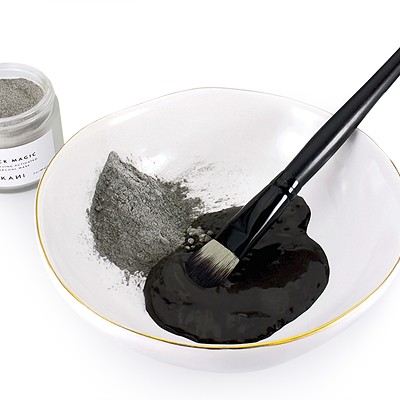Americans love their hygiene routines; the majority of us shower daily out of habit or in fear of social ostracism. And those who don't engage in this quotidian practice often protect their dirty secret by denying it.
While most of us are devoted to our regimental bathing, shampooing hair everyday is becoming less compulsory. According to an ongoing poll on Quibblo.com, only 38 percent of respondents shampoo every day, and 27 percent every other day. But there's a fringe group who eschew washing their hair altogether, and I desperately want to join their ranks.
Before my admission becomes your permission to avoid me in small spaces, hear me out on the unscented pages of this magazine.
Did you know? Shampoo is a relatively new concept. Our English word is derived from the Hindi champo, a term referring to massage. The original Indian practice involved rubbing oil into the scalp, but later evolved to using soap. Not until the 20th century was liquid shampoo introduced to the masses, first by Hans Schwarzkopf in Europe, and then by Dr. John Breck in the United States.
But few years ago, a movement to forego shampoo began to grow. Essentially, the argument was that commercial shampoos not only contain a lot of dubious chemicals, but that modern hair is simply over-washed. Too much scrubbing robs the hair and scalp of natural oils, resulting in thinning hair and unhealthy scalp conditions. "No 'Poo" devotees reported astonishing improvements in their hair after weeks without shampoo. Rather than being a greasy, smelly mess, hair became lustrous, thick and shiny.
My journey to find a shampoo-less hair cleanser that didn't leave my locks either damaged or disgusting was fraught with failures and then crowned with discovery.
I embarked on experiments with Google as my trusty guide. When searching for ways to wash my hair sans soap, the most common procedure I found was to employ baking soda and vinegar. The basic premise of this "No 'Poo" technique involves dissolving one part baking soda in three parts distilled water, cleansing and rinsing the scalp, and then rinsing again with diluted apple cider vinegar. But I didn't try this method, because further research enlightened me to the importance of pH levels. Our hair prefers products with an acidic pH between 4.5 and 5.5.
If you are a fellow No 'Poo-er, exercise caution when using baking soda and vinegar. Baking soda is alkaline, with a pH level of 9, and lifts the hair's cuticle layer, weakening the underlying salt bonds. Over time, hair exposed to this treatment may become brittle and break. Finishing with an acidic vinegar rinse does close the cuticle, but in the long run, it's an exhausting ritual for hair.
So for my first attempt at 'poo-less hair, I relied on the popular Wellness Mama website to instruct me. Her favorite homemade shampoo is a concoction of castile soap and coconut milk, followed by an ACV (apple cider vinegar) rinse. For good measure, I perfumed mine with grapefruit essential oil.
Result? My children avoided standing within 5 feet of me for the next two days. All agreed that I'd somehow recreated the scent of vomit. My son's favorite pastime became tricking unsuspecting victims into inhaling a whiff of my mane, and then giggling nefariously at their reaction. My husband, also repulsed, threatened to occupy one of our guest rooms until I improved my aura.
In my desperate attempt to solve the problem on my next go-around, I threw myself into the comments section on wellnessmama.com, searching for others who shared my fate. What I found instead were cautions against using castile soap as shampoo, since its pH level hovers between 8.9 and 10.
My next foray into homemade hair care came in the form of oatmeal. Many African American women swear by its benefits, so I decided to give it a shot. I watched several YouTube videos about how to make a rinse using colloidal oatmeal (a fancy term for finely ground oats). Avoiding the risk of another monetary loss and a potential failure, I decided to make it myself using my Magic Bullet processor. Maybe if I owned a Vitamix instead, this story would have ended happily. Alas, I ground my oatmeal into the finest powder that Magic Bullet offered, then added plain yogurt and filtered water, and into the shower I ventured.
Following a vigorous head scrub, I recruited my reluctant daughter to help comb out the resulting mess of tiny oatmeal bits interspersed throughout my unruly mop. Lest you think this an easy task, let me assure you otherwise. I have a ton of hair. A New York hair stylist once bestowed on me the nickname Mufasa during my brief stint as a Redken hair model. I gave up on homemade colloidal oatmeal.
At this point, some may wonder why I pressed on. I can only answer that I am as stubborn as a mustard stain on your favorite white shirt. So I dove into my next prospect: bentonite clay. I read that this powder detoxifies hair, and also removes oil. Yes, please!
At nearly $13 for 16 fast-disappearing ounces — in addition to a fairly messy and involved application process — bentonite clay was not my long-term solution. The good news is that it worked fairly well, and I received several compliments from people not aware of my ongoing experiments. So I tucked it away for occasional use, or as backup if future trials required an emergency rescue treatment.
My mistakes were teaching me, though. I began targeting my internet queries toward pH-balanced, relatively simple shampoo alternatives. I stumbled across soapnuts. At $11.95 for a half-pound bag that would last for months, the value was inviting.
Surprise! Soapnuts (or aritha/reetha) aren't nuts. They're the dried berries of the genus Sapindus, in the Lychee family of trees and shrubs. Soapnuts contain saponins, which are a natural surfactant (detergent). The people of India have used them for centuries in a variety of applications, including shampoo. They usually add other ingredients like shikakai, amla, neem oil, fenugreek seeds and herbs to make their decoctions more effective.
After playing with several recipes, I landed on one that works for me. And not a moment too soon! Not long ago, a family of wrens eyed my tresses as a possible nesting spot. Thankfully, as I was nearing the two-month mark of my journey, my hair was finally under control.
Once again, it is safe to stand near me without fear of odiferous reprisals. But I keep tinkering. So if someday my son asks you to sniff my hair, run. ♦
Gently boil 5 seeded soapnuts in 2 cups of distilled water for 20 minutes. Strain liquid into a glass or plastic bowl. (Keep your soapnuts! They can be reused several times before discarding.) Add 1 tablespoon each of shikakai and amla powders to the soapnut decoction. Allow this mixture to rest, covered, several hours or overnight in the refrigerator. Strain the mixture through cheesecloth and transfer to an unbreakable container before applying it, in the shower, to dry scalp and hair. (Or wet, if you prefer.) Massage it into the scalp, working the liquid from root to tip. Leave on for at least 5 minutes before rinsing. Shikakai can be drying, so coconut (or other) oil may be applied to the ends of your hair before washing in order to retain moisture. If desired, an ACV (apple cider vinegar) rinse may be used afterward in a ratio of 1 to 2 tablespoons per 8 ounces water. Rinse hair before drying and styling as usual. Any unused 'shampoo' can be stored in the refrigerator up to a week.



















